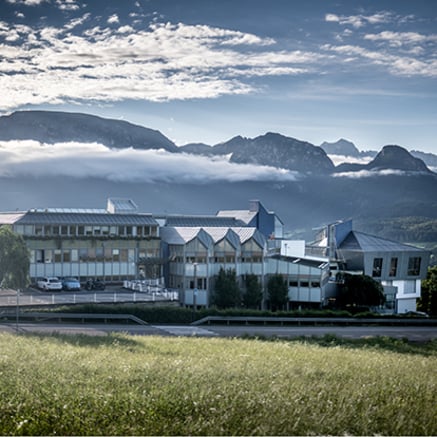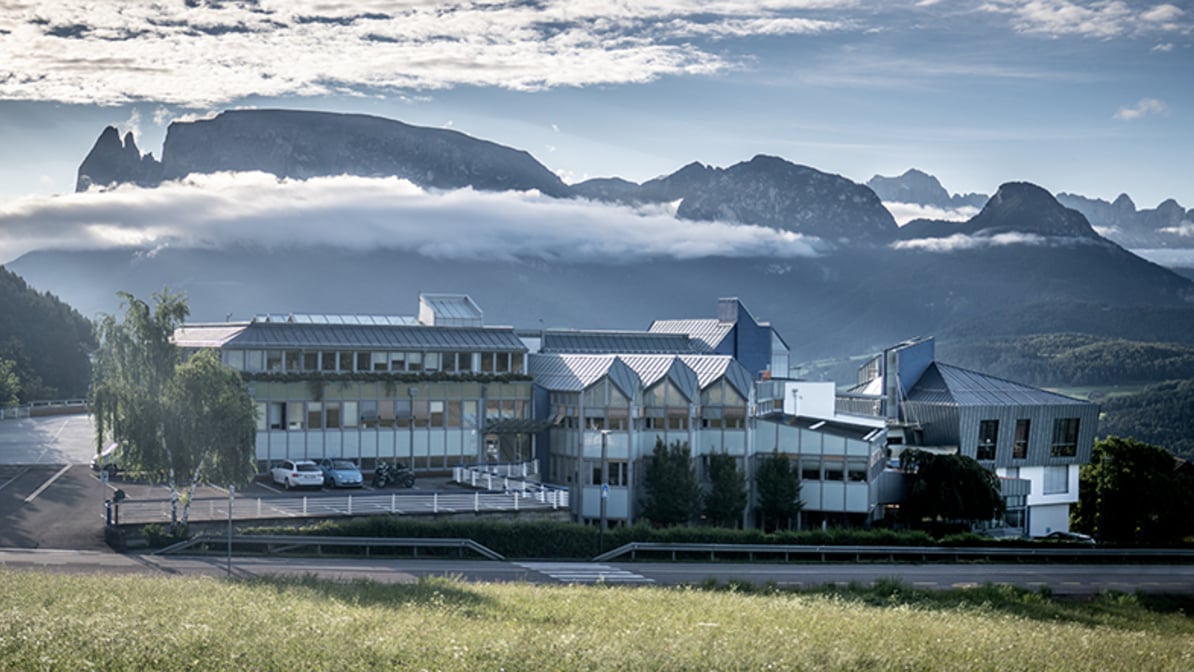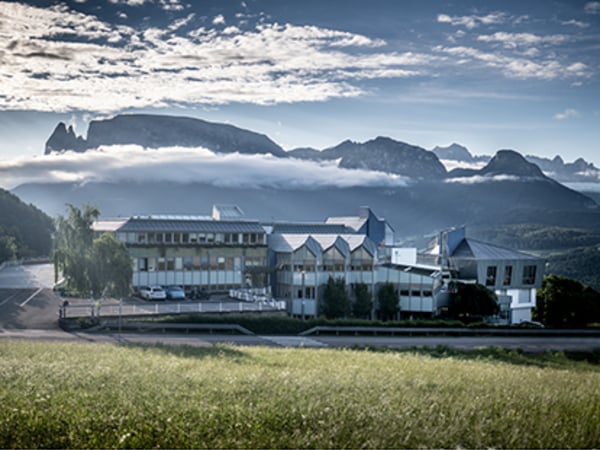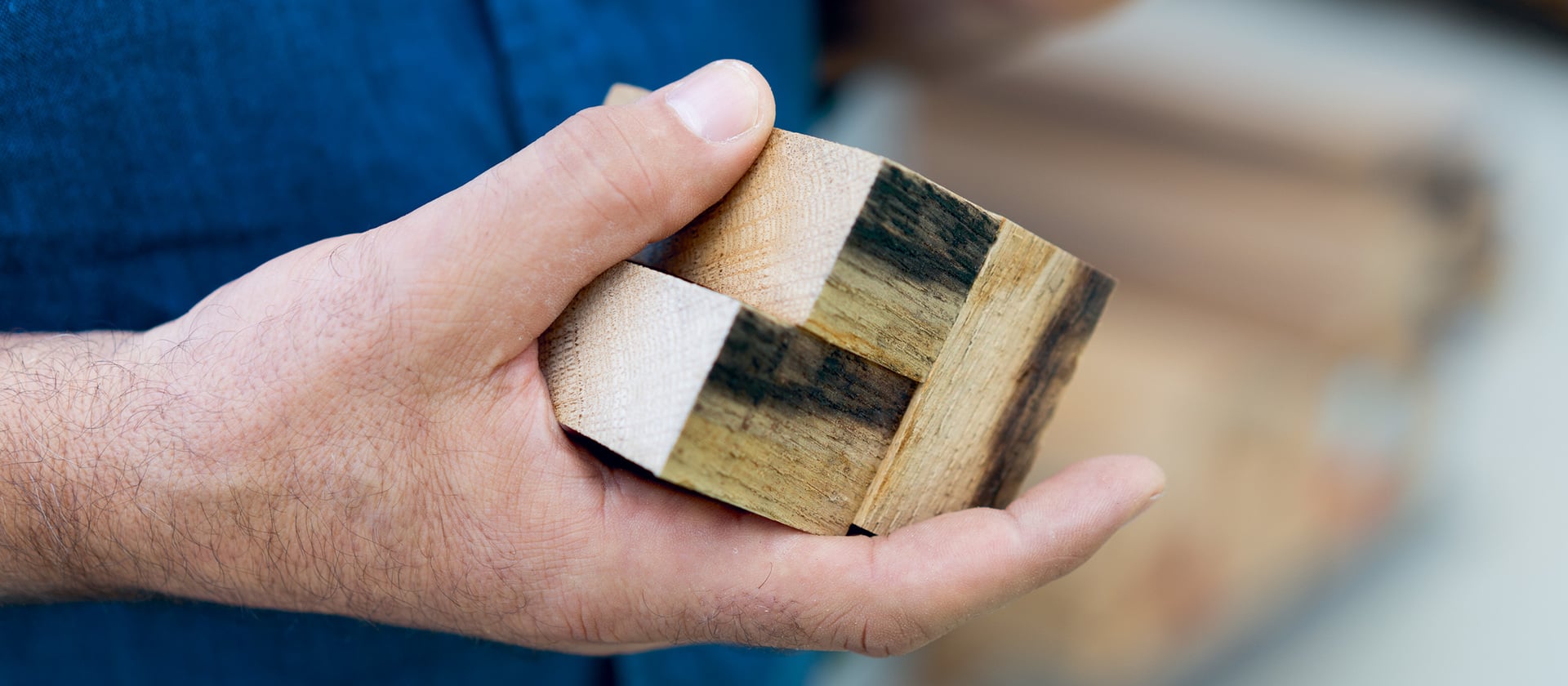
From board to frame.
Living material. Florian Oberrauch talks about high-quality wood processing.
The raw material comes from the forest. The material we use comes from the sawmill. And Finstral turns the boards into high-quality wood veneers. By setting up its own wood processing operation, this family company is returning to its roots – thus showing that real wood also has a future in window construction. A discussion with Florian Oberrauch.
Interview: Barbara Teichelmann
Finstral started with wood production in 2010...Florian Oberrauch Yes, that was the beginning. In those days our production was very different. We bought profiled, ready-painted wooden slats that we would then cut and assemble ourselves.
Why and when did you decide to do everything yourselves?We were not happy because the work processes were neither flexible nor could they be expanded. For example, we had to bring the slats together at a 45-degree angle – like in a uPVC window. But modern wooden windows have a 90 degree step-corner joint. This satisfied neither our customers nor us. We quickly realised that we had to change something. And so we were faced with the decision: either we do it right and produce wooden windows entirely by ourselves, or we carry on as before. The decision was made almost two years ago: we then set up our own wood production line in our plant in Oppeano, near Verona, and started production in early 2018.
So the aim was greater quality?We wanted to develop further, from wood assemblers to wood processors. And we wanted to have control over absolutely every detail. Now we ourselves make our wooden windows, from the board to the frame – that makes us very proud. Wood actually lies at our origins, as my uncle Hans Oberrauch, the founder of Finstral, was a carpenter. So we were all the more concerned that we could not offer the high quality here that is otherwise our standard.
You offer two types of wood – spruce and oak.Looking northwards, it is softwood that is traditionally used in window construction. If you look south, hardwood is increasingly used, especially in Italy. Spruce and oak – with these we can cover the two major demands for wood. Because we of course asked: what are the market requirements? It was also important to avoid long distances and to use local wood where possible. We would never import wood from Canada, for example. Why is that? We are practically sitting on the source: 40 percent of South Tyrol is covered with forest and 60 percent of that is spruce. That is why we source our spruce wood solely from South Tyrol.
Interview: Barbara Teichelmann
Finstral started with wood production in 2010...Florian Oberrauch Yes, that was the beginning. In those days our production was very different. We bought profiled, ready-painted wooden slats that we would then cut and assemble ourselves.
Why and when did you decide to do everything yourselves?We were not happy because the work processes were neither flexible nor could they be expanded. For example, we had to bring the slats together at a 45-degree angle – like in a uPVC window. But modern wooden windows have a 90 degree step-corner joint. This satisfied neither our customers nor us. We quickly realised that we had to change something. And so we were faced with the decision: either we do it right and produce wooden windows entirely by ourselves, or we carry on as before. The decision was made almost two years ago: we then set up our own wood production line in our plant in Oppeano, near Verona, and started production in early 2018.
So the aim was greater quality?We wanted to develop further, from wood assemblers to wood processors. And we wanted to have control over absolutely every detail. Now we ourselves make our wooden windows, from the board to the frame – that makes us very proud. Wood actually lies at our origins, as my uncle Hans Oberrauch, the founder of Finstral, was a carpenter. So we were all the more concerned that we could not offer the high quality here that is otherwise our standard.
You offer two types of wood – spruce and oak.Looking northwards, it is softwood that is traditionally used in window construction. If you look south, hardwood is increasingly used, especially in Italy. Spruce and oak – with these we can cover the two major demands for wood. Because we of course asked: what are the market requirements? It was also important to avoid long distances and to use local wood where possible. We would never import wood from Canada, for example. Why is that? We are practically sitting on the source: 40 percent of South Tyrol is covered with forest and 60 percent of that is spruce. That is why we source our spruce wood solely from South Tyrol.
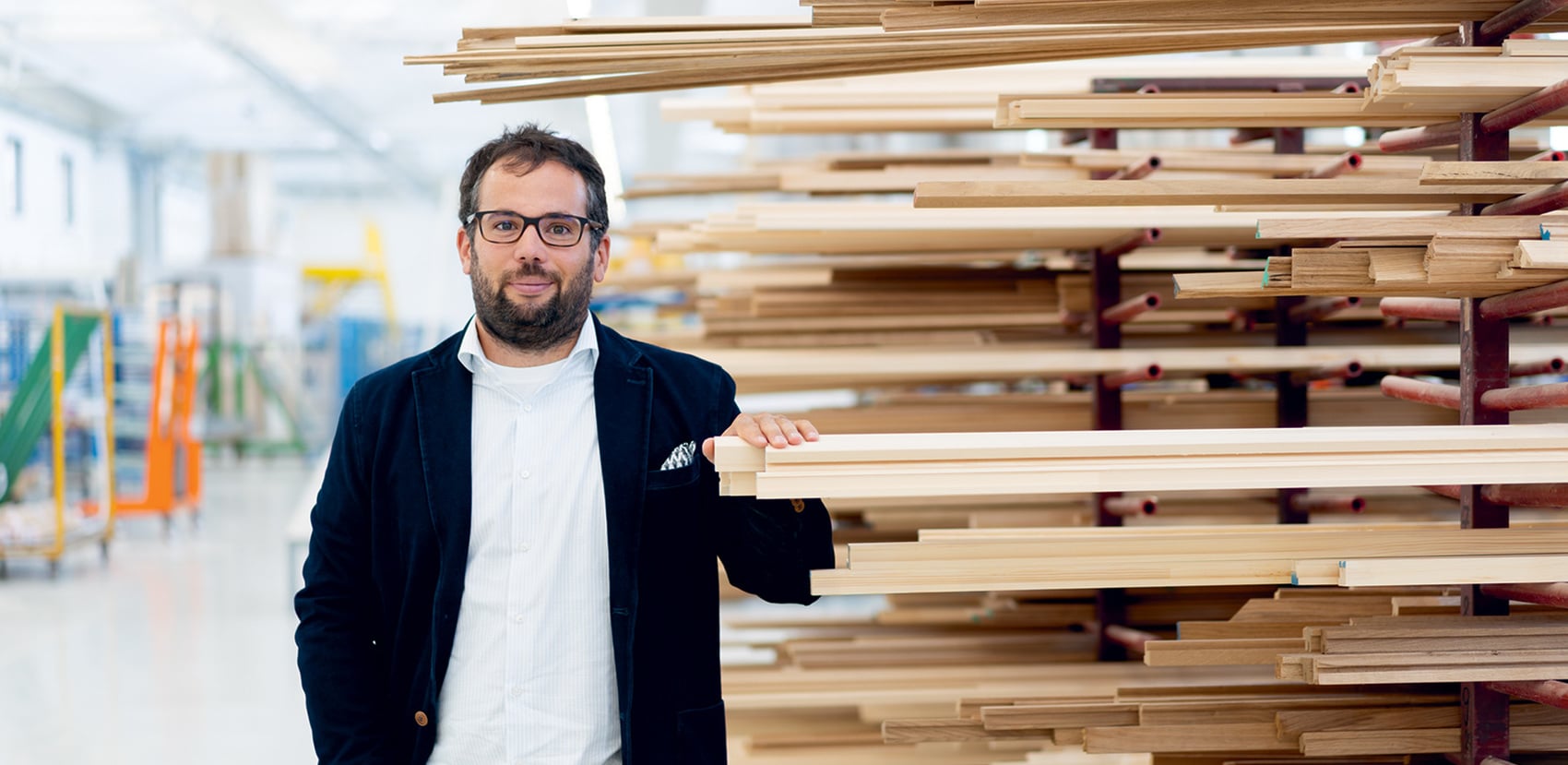
Everything from a single source: Florian Oberrauch, member of the board of directors and responsible for production and logistics, is proud of the company’s high-quality wood processing.
People and wood
It’s back. Although it never actually went away. Wood is a material that lives, breathes and moves, one with which a lot of people feel very comfortable. “Wood works,” is something often said when we hear creaking in old farmhouses, and it is true: depending on the indoor climate, wood will release moisture or absorb it from the air. Wood filters and binds harmful substances and, thanks to the essential oils it contains, it has a pleasant and soothing scent. Wood can even store heat, thus creating a cosy atmosphere. Experience and respect are required when dealing with this valuable material – Finstral therefore uses regional wood from sustainable forests.
Forest and wood
Where else should we find it? Holz Pichler, South Tyrol’s largest sawmill, is located in the midst of a forest in the Eggen Valley up in the Dolomites. A thousand tree trunks are processed here every day, into boards of three different thicknesses from which furniture is made, floors, pianos, picture frames, caravans – and Finstral windows. From the first longitudinal cut on the bandsaw you can see what the wood of a log is like and what it is best suited for. Ideally, every piece of wood, no matter how small, will be recycled as only what can be replanted can be taken from the forest – within a maximum radius of forty kilometres.
Finstral and wood
When the spruce and oak boards from South Tyrol and Slovenia arrive at Oppeano, a modern, bright and spacious hall awaits them: Finstral’s wood production plant. On the one hand, here you can find high-tech – with machines for automatic planing, milling, drilling and a paint shop with a robot known to the staff as “Beppi”. On the other, testing, feeling, grinding and brushing all rely on manual work and experience. Wood is a living material and has to be treated with particular care.
It’s back. Although it never actually went away. Wood is a material that lives, breathes and moves, one with which a lot of people feel very comfortable. “Wood works,” is something often said when we hear creaking in old farmhouses, and it is true: depending on the indoor climate, wood will release moisture or absorb it from the air. Wood filters and binds harmful substances and, thanks to the essential oils it contains, it has a pleasant and soothing scent. Wood can even store heat, thus creating a cosy atmosphere. Experience and respect are required when dealing with this valuable material – Finstral therefore uses regional wood from sustainable forests.
Forest and wood
Where else should we find it? Holz Pichler, South Tyrol’s largest sawmill, is located in the midst of a forest in the Eggen Valley up in the Dolomites. A thousand tree trunks are processed here every day, into boards of three different thicknesses from which furniture is made, floors, pianos, picture frames, caravans – and Finstral windows. From the first longitudinal cut on the bandsaw you can see what the wood of a log is like and what it is best suited for. Ideally, every piece of wood, no matter how small, will be recycled as only what can be replanted can be taken from the forest – within a maximum radius of forty kilometres.
Finstral and wood
When the spruce and oak boards from South Tyrol and Slovenia arrive at Oppeano, a modern, bright and spacious hall awaits them: Finstral’s wood production plant. On the one hand, here you can find high-tech – with machines for automatic planing, milling, drilling and a paint shop with a robot known to the staff as “Beppi”. On the other, testing, feeling, grinding and brushing all rely on manual work and experience. Wood is a living material and has to be treated with particular care.
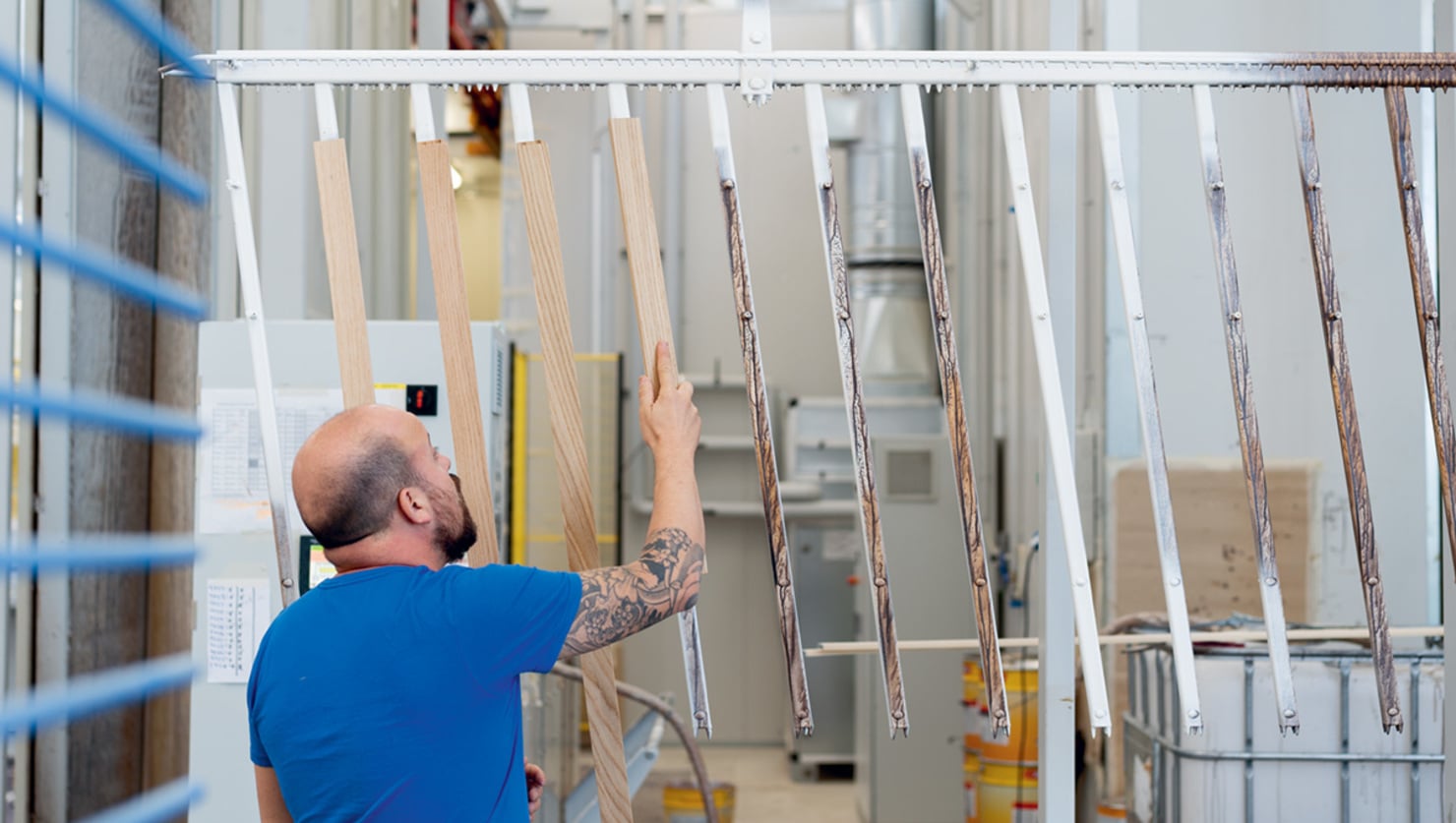
After priming, intermediate sanding and paint spraying, the wooden profiles are hung up on the paint line. Final painting is fully automatic.

In top form: the freshly milled wooden profiles for FIN-Vista window walls and FIN-Slide lift-and-slide doors wait on a trolley to be painted. The colour markings come from the sawmill and will be cut off.
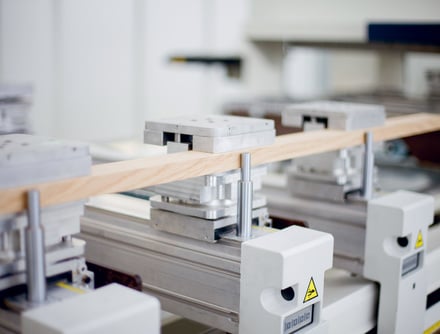
Sawing, milling, drilling: a CNC machine takes care of all this at the Finstral woodworking plant near Verona.

The finished window sash with its wood veneer is transported to the “wedding” – this is the name given when inserting it into the window frame.
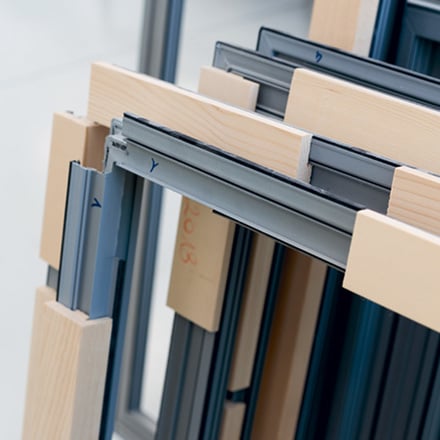
Test samples are made so as to continuously monitor the quality of the interaction between wooden and uPVC profiles.
And what about oak wood?
Oak does not grow here, so we import it from Slovenia. And, just like the spruce we use, the oak comes from sustainable forests. This is how we do our part to ensure that the forests are preserved in the long term. We are also very economical with this valuable raw material.
Is the decision to use hardwood or softwood purely aesthetic, or are there also functional reasons?Softwood is more sensitive than hardwood, but that is only a factor in production – the customer will not notice the difference. Spruce has fewer defects in the wood, as well as a uniform grain that offers a very nice, homogeneous surface. With oak there is more life in the wood, there are more blemishes such as knotholes or dark spots. Oak is not perfect, but it is just what the customer wants. In short: hardwood is hard and softwood is soft, but that’s about the limit of the functional differences. The rest is purely a matter of taste.
Wood is a living material. To what extent does this affect production?It was a major challenge at first. Luckily for us, we had begun production in Oppeano because the area around Verona has a long tradition of manufacturing wooden furniture. So we quickly found people with plenty of skills and experience.
What were the challenges?We struggled to find a quality standard. How many defects in the surface of the wood are still acceptable? That is of course also a question of taste: one customer says he likes a lot of knots, the other doesn’t want to see a single one. So what do you cut out, what is waste and what isn’t? You have to determine that yourself, there are no set rules. Finding a middle ground that will be accepted across Europe – that was the biggest challenge in the beginning. It was especially difficult with oak. Sometimes we threw 50 percent away. Nowadays our suppliers in South Tyrol and Slovenia know exactly what we want, however.
How can you tell whether the wood quality is right?We immediately check the wood for moisture, for example. Ten percent, plus or minus two, is fine. If it is too dry, we will have processing problems. Then we will get more tears on the milling machine. Otherwise we decide purely on the basis of visual inspection: we have set parameters with sample photos and trained our employees accordingly. Now everyone knows what a defect is and what we can allow to pass.
So far Finstral has only used wood on the interior of its products. Will you ever manufacture windows and doors made entirely of wood?No, definitely not. We will always use uPVC at the core. It is leak-proof, corner-welded, waterproof, can be glued to the insulation glass and permanently and securely screwed to the fittings. Wood is clearly at a disadvantage in functional terms because it weathers under the influence of sun and moisture. And you simply cannot make a wooden frame that is completely and permanently watertight. But wood is attractive. That is why we use it on the inside. For certain types of buildings, and despite its disadvantages, wood is more stylish on the outside. And our modular frame structure means that a solution with wood both outside and inside would also in principle be possible.
Why are solid wood windows still so popular with builders and architects?In our view, there are two reasons: first, the functional disadvantages of wooden windows are simply underestimated. When talking to customers we often notice that these problems are not really known about or they are downplayed. The second and probably more decisive reason is aesthetics. Many architects and builders associate wooden windows with a slim frame appearance and the natural, warm effect of this material. Our approach for a really innovative wooden window is therefore to combine both the perfect function of uPVC in the core with the special aesthetics of wood. Because, thanks to modern window construction technology, extremely narrow uPVC frames can also now be made. And the uPVC core can be beautifully veneered with real wood so that you don’t have to forgo the fine wooden surface.
“We combine the perfect function with the special aesthetics of wood.”
Florian Oberrauch
Oak does not grow here, so we import it from Slovenia. And, just like the spruce we use, the oak comes from sustainable forests. This is how we do our part to ensure that the forests are preserved in the long term. We are also very economical with this valuable raw material.
Is the decision to use hardwood or softwood purely aesthetic, or are there also functional reasons?Softwood is more sensitive than hardwood, but that is only a factor in production – the customer will not notice the difference. Spruce has fewer defects in the wood, as well as a uniform grain that offers a very nice, homogeneous surface. With oak there is more life in the wood, there are more blemishes such as knotholes or dark spots. Oak is not perfect, but it is just what the customer wants. In short: hardwood is hard and softwood is soft, but that’s about the limit of the functional differences. The rest is purely a matter of taste.
Wood is a living material. To what extent does this affect production?It was a major challenge at first. Luckily for us, we had begun production in Oppeano because the area around Verona has a long tradition of manufacturing wooden furniture. So we quickly found people with plenty of skills and experience.
What were the challenges?We struggled to find a quality standard. How many defects in the surface of the wood are still acceptable? That is of course also a question of taste: one customer says he likes a lot of knots, the other doesn’t want to see a single one. So what do you cut out, what is waste and what isn’t? You have to determine that yourself, there are no set rules. Finding a middle ground that will be accepted across Europe – that was the biggest challenge in the beginning. It was especially difficult with oak. Sometimes we threw 50 percent away. Nowadays our suppliers in South Tyrol and Slovenia know exactly what we want, however.
How can you tell whether the wood quality is right?We immediately check the wood for moisture, for example. Ten percent, plus or minus two, is fine. If it is too dry, we will have processing problems. Then we will get more tears on the milling machine. Otherwise we decide purely on the basis of visual inspection: we have set parameters with sample photos and trained our employees accordingly. Now everyone knows what a defect is and what we can allow to pass.
So far Finstral has only used wood on the interior of its products. Will you ever manufacture windows and doors made entirely of wood?No, definitely not. We will always use uPVC at the core. It is leak-proof, corner-welded, waterproof, can be glued to the insulation glass and permanently and securely screwed to the fittings. Wood is clearly at a disadvantage in functional terms because it weathers under the influence of sun and moisture. And you simply cannot make a wooden frame that is completely and permanently watertight. But wood is attractive. That is why we use it on the inside. For certain types of buildings, and despite its disadvantages, wood is more stylish on the outside. And our modular frame structure means that a solution with wood both outside and inside would also in principle be possible.
Why are solid wood windows still so popular with builders and architects?In our view, there are two reasons: first, the functional disadvantages of wooden windows are simply underestimated. When talking to customers we often notice that these problems are not really known about or they are downplayed. The second and probably more decisive reason is aesthetics. Many architects and builders associate wooden windows with a slim frame appearance and the natural, warm effect of this material. Our approach for a really innovative wooden window is therefore to combine both the perfect function of uPVC in the core with the special aesthetics of wood. Because, thanks to modern window construction technology, extremely narrow uPVC frames can also now be made. And the uPVC core can be beautifully veneered with real wood so that you don’t have to forgo the fine wooden surface.
“We combine the perfect function with the special aesthetics of wood.”
Florian Oberrauch
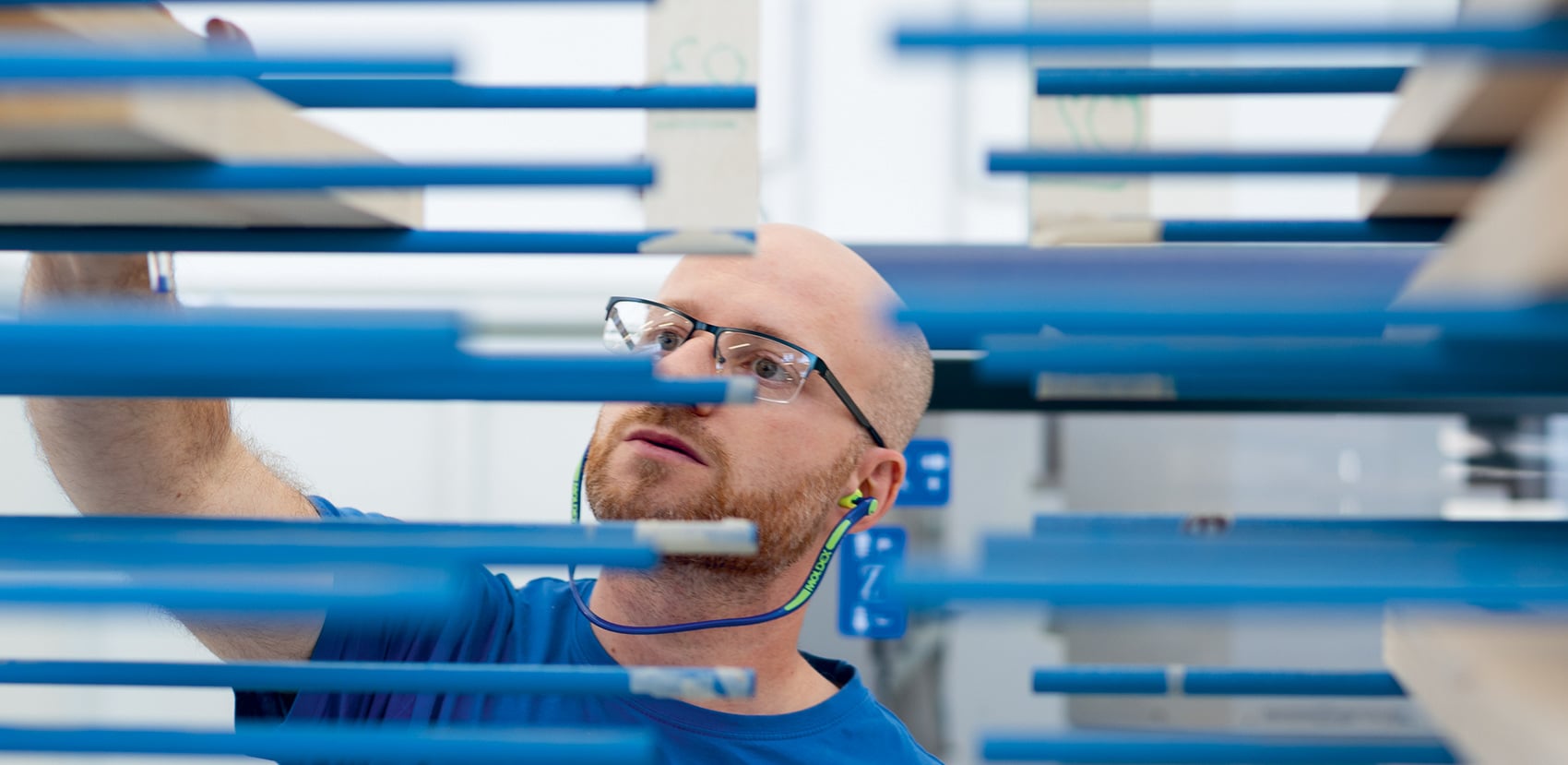
All in order: the profiles are checked one by one for quality. Finstral produces a total of over 45 different geometries for wooden windows.
Your wooden windows are thus basically a uPVC profile with a wood veneer inside and, optionally, with an aluminium facing outside.Yes, our windows are modular and can thus combine the advantages of three materials. Many experts warned us that it wouldn’t work that way, as the three materials behave too differently from one another.
But since wood and aluminium are “only” facings, do the three materials remain relatively independent?Yes and no, because they are mechanically joined to each other. And the materials work, each for itself and each differently: for example, they expand in varying degrees when subject to temperature fluctuations. You have to get control over this otherwise the frames will warp. That looks ugly and of course functionality suffers too. So we tried and tested. We learned a lot about the details that matter.
Trying and testing and handling everything on your own – is that a Finstral principle?I wouldn’t put it like that. We simply benefit enormously from having a very wide range of skills in-house. This allows us to tackle issues ourselves and solve them together. We develop, try things out, develop them further and this helps us to maintain a very open level of corporate communication. From production to assembly, from system technology to purchasing and sales, everyone contributes something. If I suggest something and the machinist says to me, “Florian, it won’t work that way”, well, it just won’t work. This hierarchy-free way of working is particularly valuable for complex new developments such as our wooden windows. And success has proven us right. In the first year we delivered over 10,000 wooden windows.
What does a wooden window have to do on the inside?Aesthetics come first, which means that it above all has to be attractive. And it will have to withstand greater moisture in the kitchen and bathroom, to stop any stains or discolouration from forming. This is why we paint our wooden frames, but only with water-soluble paints that are harmless to the environment.
So the windows can be dumped into the organic waste?Yes, you can easily remove and dispose of a wooden frame, for example by burning it. Or turning it into wood chips. UPVC can be completely melted down, while aluminium can also be 100 percent recycled. And if, after five years you no longer like the colour of the wood, you can call us, order new wooden frames for the sash and simply replace the old ones.
And how do you deal with damp during the construction phase?This is indeed a problem, because wooden windows are quite prone to damage. Damp is certainly an issue, and one that generally affects comparatively soft materials faster. It is therefore a complete mystery to us that in most European countries windows are still installed during the wet construction phase. There has long been an intelligent solution, namely the mounting frame: you plaster a frame into the reveal and install the finished windows only in the dry construction phase. For high-quality windows in new buildings, the mounting frame is the only correct method – and especially with wooden windows, I strongly advise against anything else.
How has the timber business developed for you as a window manufacturer in recent years? And what are the prospects?I don’t have any market data to hand, but wood has a role to play in every country. And we think that demand will continue to increase in the next few years. That was one reason why we have invested now. And yet another argument in favour: Finstral windows always have a uPVC core. But beyond this functional quality standard, we want to offer discerning customers the greatest possible variety of designs. And wood as a material is simply part of this.
But since wood and aluminium are “only” facings, do the three materials remain relatively independent?Yes and no, because they are mechanically joined to each other. And the materials work, each for itself and each differently: for example, they expand in varying degrees when subject to temperature fluctuations. You have to get control over this otherwise the frames will warp. That looks ugly and of course functionality suffers too. So we tried and tested. We learned a lot about the details that matter.
Trying and testing and handling everything on your own – is that a Finstral principle?I wouldn’t put it like that. We simply benefit enormously from having a very wide range of skills in-house. This allows us to tackle issues ourselves and solve them together. We develop, try things out, develop them further and this helps us to maintain a very open level of corporate communication. From production to assembly, from system technology to purchasing and sales, everyone contributes something. If I suggest something and the machinist says to me, “Florian, it won’t work that way”, well, it just won’t work. This hierarchy-free way of working is particularly valuable for complex new developments such as our wooden windows. And success has proven us right. In the first year we delivered over 10,000 wooden windows.
What does a wooden window have to do on the inside?Aesthetics come first, which means that it above all has to be attractive. And it will have to withstand greater moisture in the kitchen and bathroom, to stop any stains or discolouration from forming. This is why we paint our wooden frames, but only with water-soluble paints that are harmless to the environment.
So the windows can be dumped into the organic waste?Yes, you can easily remove and dispose of a wooden frame, for example by burning it. Or turning it into wood chips. UPVC can be completely melted down, while aluminium can also be 100 percent recycled. And if, after five years you no longer like the colour of the wood, you can call us, order new wooden frames for the sash and simply replace the old ones.
And how do you deal with damp during the construction phase?This is indeed a problem, because wooden windows are quite prone to damage. Damp is certainly an issue, and one that generally affects comparatively soft materials faster. It is therefore a complete mystery to us that in most European countries windows are still installed during the wet construction phase. There has long been an intelligent solution, namely the mounting frame: you plaster a frame into the reveal and install the finished windows only in the dry construction phase. For high-quality windows in new buildings, the mounting frame is the only correct method – and especially with wooden windows, I strongly advise against anything else.
How has the timber business developed for you as a window manufacturer in recent years? And what are the prospects?I don’t have any market data to hand, but wood has a role to play in every country. And we think that demand will continue to increase in the next few years. That was one reason why we have invested now. And yet another argument in favour: Finstral windows always have a uPVC core. But beyond this functional quality standard, we want to offer discerning customers the greatest possible variety of designs. And wood as a material is simply part of this.
Still want more?
See here for further interesting reading matter.


Department of Gestaltungslehre and Design – Technical University of Vienna.
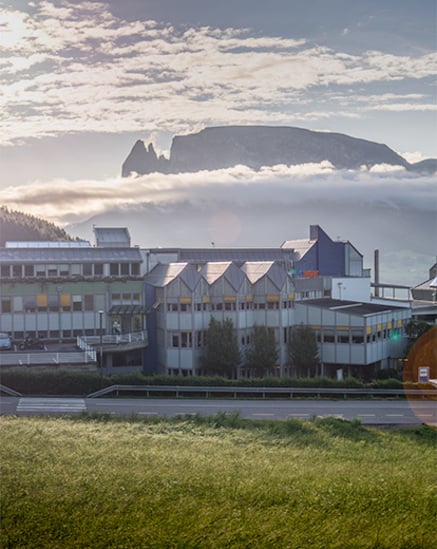
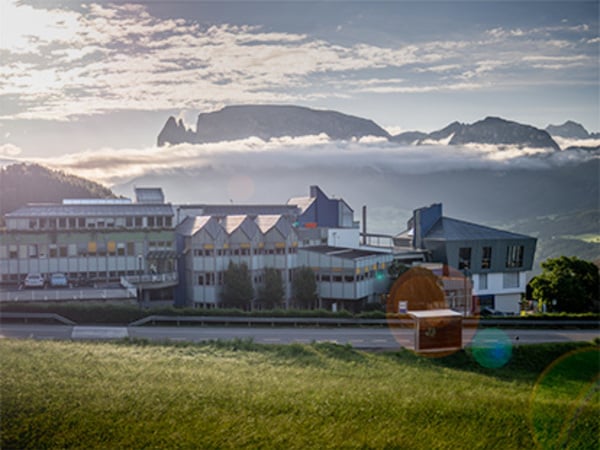
The South-Tyrolean family business is among the biggest window suppliers in Europe.
